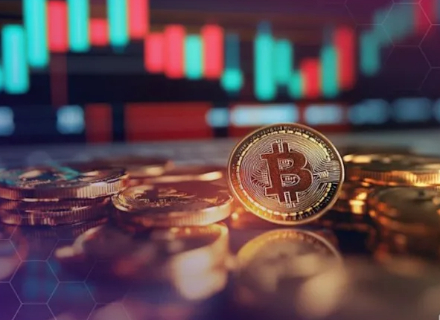Written by: Chris Beamish, CryptoVizArt, Antoine Colpaert, Glassnode
Translated by: AididiaoJP, Foresight News
Bitcoin’s struggle below key cost basis levels reflects weakening demand and continued selling by long-term holders. Although volatility has cooled and options positions are relatively balanced, the market now hinges on expectations for the Federal Reserve meeting, and any hawkish surprise could reignite volatility.
Summary
-
Bitcoin rebounded over the weekend from the supply cluster between $107K and $118K, mimicking previous short-lived rebounds after all-time highs, but ongoing selling pressure from long-term holders has limited further upside.
-
The market continues to struggle above the short-term holders’ cost basis (around $113K), a key battleground between bullish and bearish momentum. Failure to reclaim this level increases the risk of a deeper pullback toward the realized price for active investors (around $88K).
-
Short-term holders are exiting at a loss, while long-term holders remain the main source of heavy selling pressure (about -104K BTC/month), indicating weakening conviction and ongoing absorption of supply.
-
Implied volatility has sharply cooled after the October crash, skew has flattened, and options flows reflect controlled upside and restrained downside hedging.
-
The current calm in volatility depends on the Fed’s next decision. A dovish outcome will maintain stability, but any hawkish surprise could reignite volatility and demand for downside protection.
On-chain Insights
Familiar Rebound Pattern
Last weekend, after briefly dipping to the lower boundary of the top buyers’ supply cluster ($107K to $118K), Bitcoin staged a short-lived recovery. According to the cost basis distribution heatmap, the price rebounded from near the $116K median, then fell back to around $113K.
This structure closely mirrors the rebound patterns observed after all-time highs in Q2–Q3 2024 and Q1 2025, where temporary rebounds occur but demand is quickly absorbed by overhead supply. In the current scenario, a fresh round of selling by long-term holders has further amplified resistance in this supply zone, highlighting how profit-taking at high levels continues to limit upside momentum.
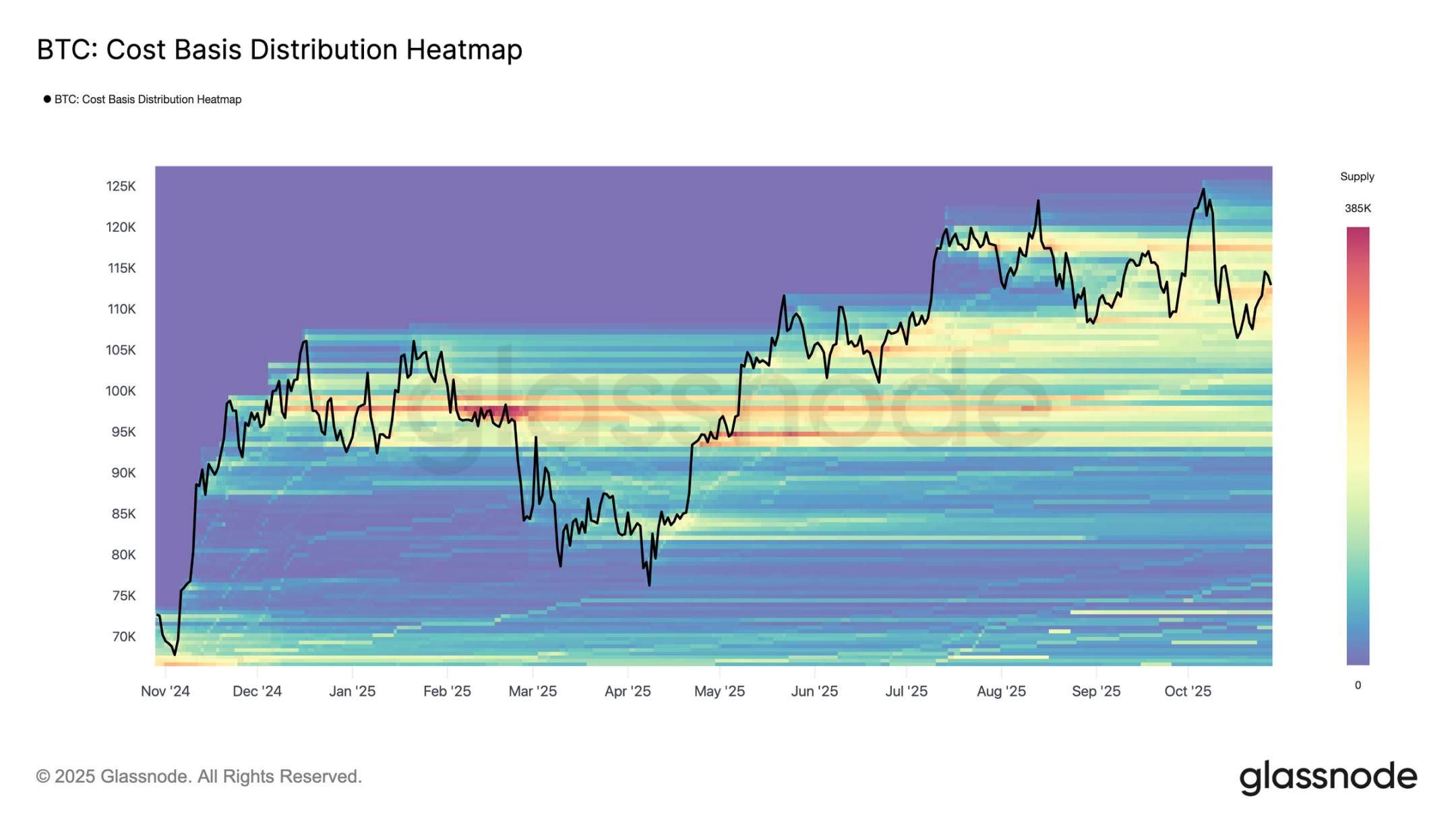
Struggling to Hold the Line
After the weekend rebound, Bitcoin briefly reclaimed the level near the short-term holders’ cost basis of about $113K, a level often seen as the dividing line between bullish and bearish momentum. Maintaining this threshold typically signals demand is strong enough to absorb ongoing selling pressure. However, failure to stay above this level—especially after trading higher for six months—indicates weakening demand.
Over the past two weeks, Bitcoin has struggled to close weekly candles above this key level, increasing the risk of further weakness ahead. If this phase continues, the next major support lies near the realized price for active investors at around $88K, a metric reflecting the cost basis of actively circulating supply and one that has often marked deeper correction phases in previous cycles.
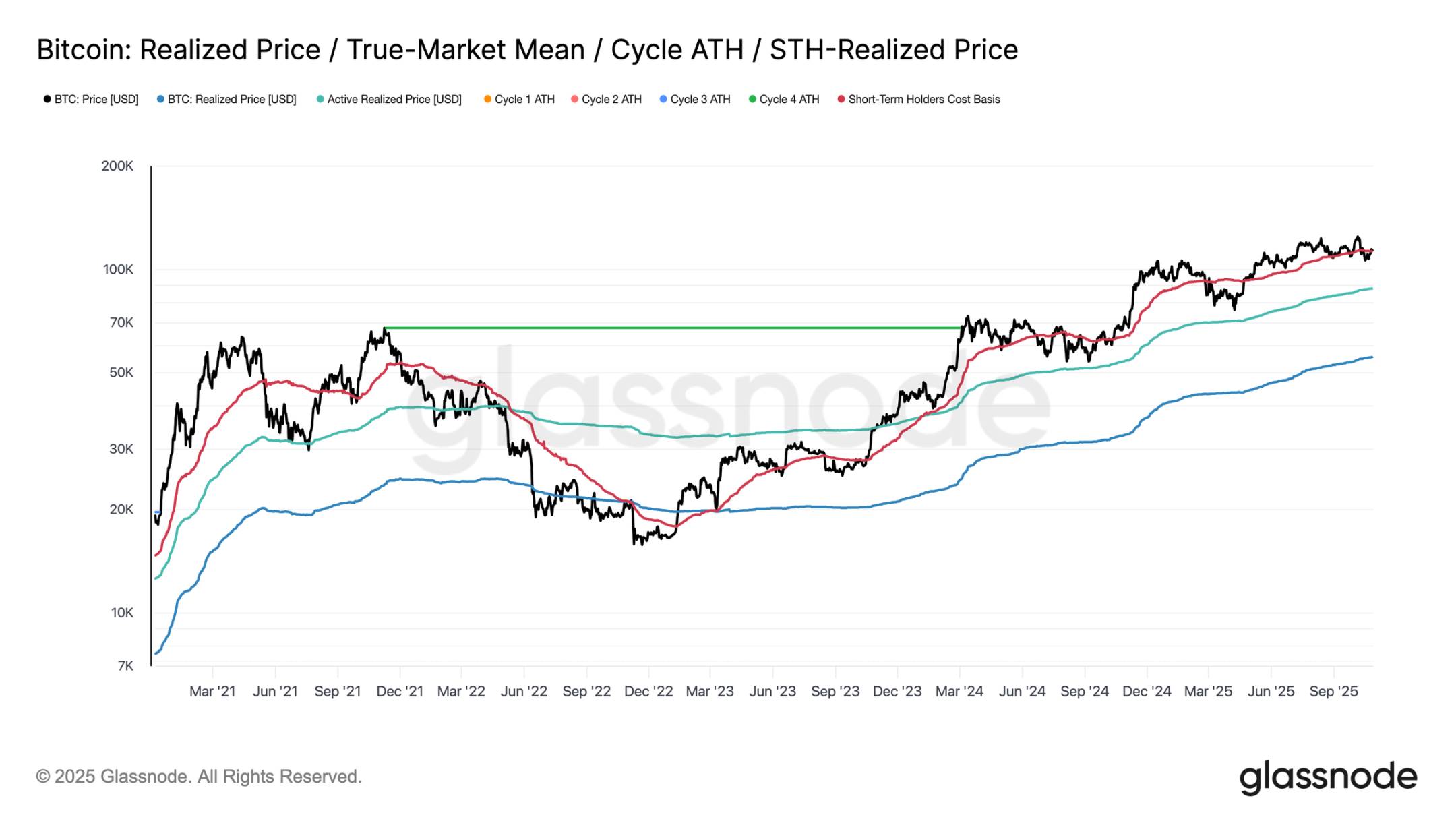
Short-term Holder Pressure
Extending the analysis to investor sentiment, further market weakness is likely to be driven by short-term holders, who are now top buyers exiting at a loss. The short-term holders’ Net Unrealized Profit/Loss (NUPL) indicator helps assess this pressure by measuring the proportion of unrealized profit or loss relative to market cap.
Historically, deeply negative values coincide with capitulation phases before market bottoming ranges form. The recent drop to $107K pushed the short-term holders’ NUPL to -0.05, a mild loss compared to the typical -0.1 to -0.2 range during mid-term bull market corrections, or below -0.2 at deep bear market lows.
As long as Bitcoin trades within the $107K–$117K top buyer cluster, the market remains in a delicate balance—not fully capitulated, but with conviction gradually eroding and the odds shifting against the bulls.
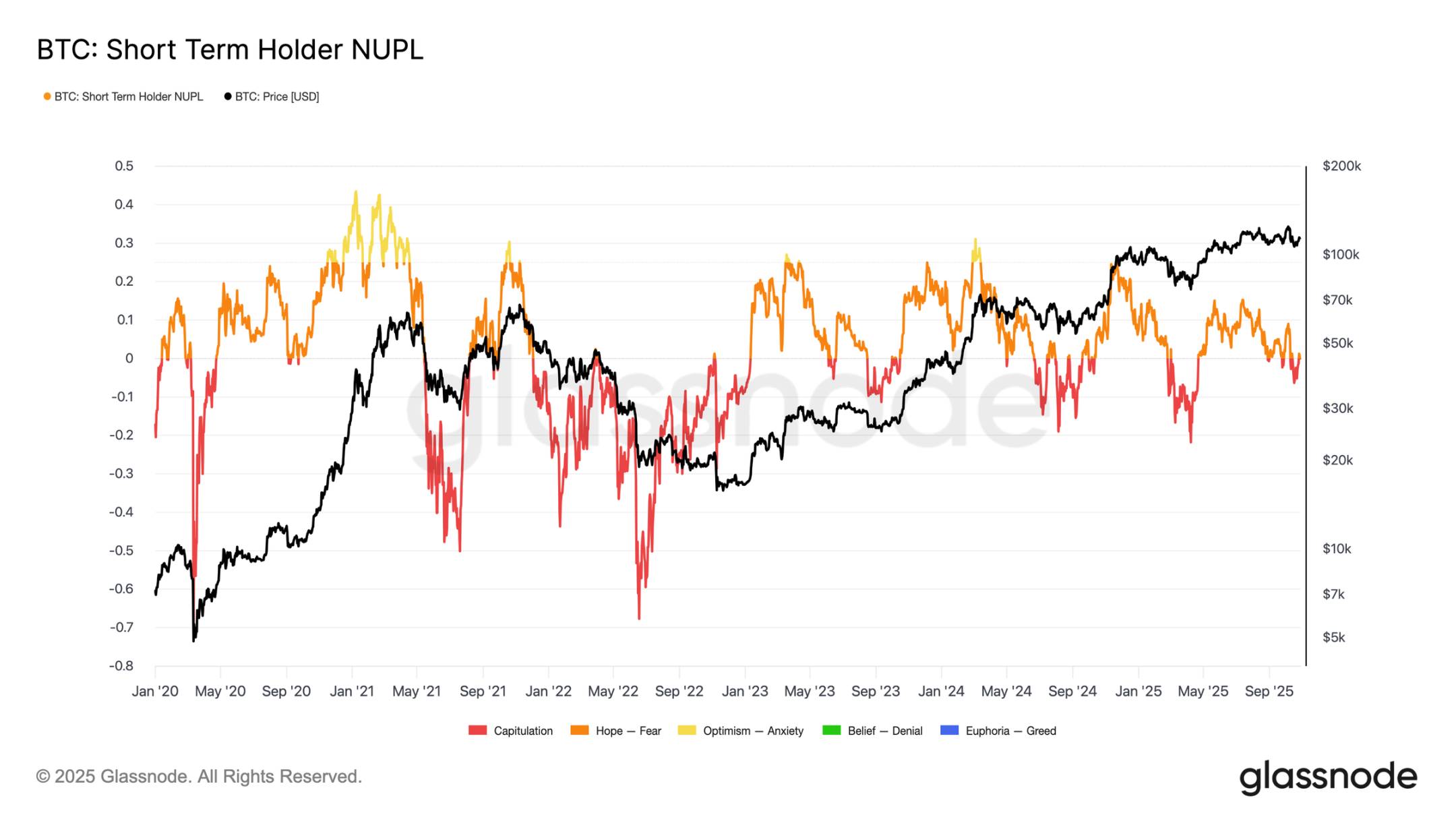
Long-term Holder Selling
Based on previous observations, continued selling by long-term holders continues to drag on market structure. The net position change for long-term holders has dropped to -104K BTC per month, highlighting the most significant wave of selling since mid-July.
This persistent selling pressure aligns with broader signs of exhaustion seen in the market, as experienced investors continue to realize profits amid weakening demand.
Historically, major market expansions have only begun after long-term holders shift from net selling to sustained accumulation. Thus, a return to net inflows by this group remains a key prerequisite for restoring market resilience and laying the foundation for the next bull phase. Until this shift occurs, long-term investor selling is likely to continue weighing on price action.
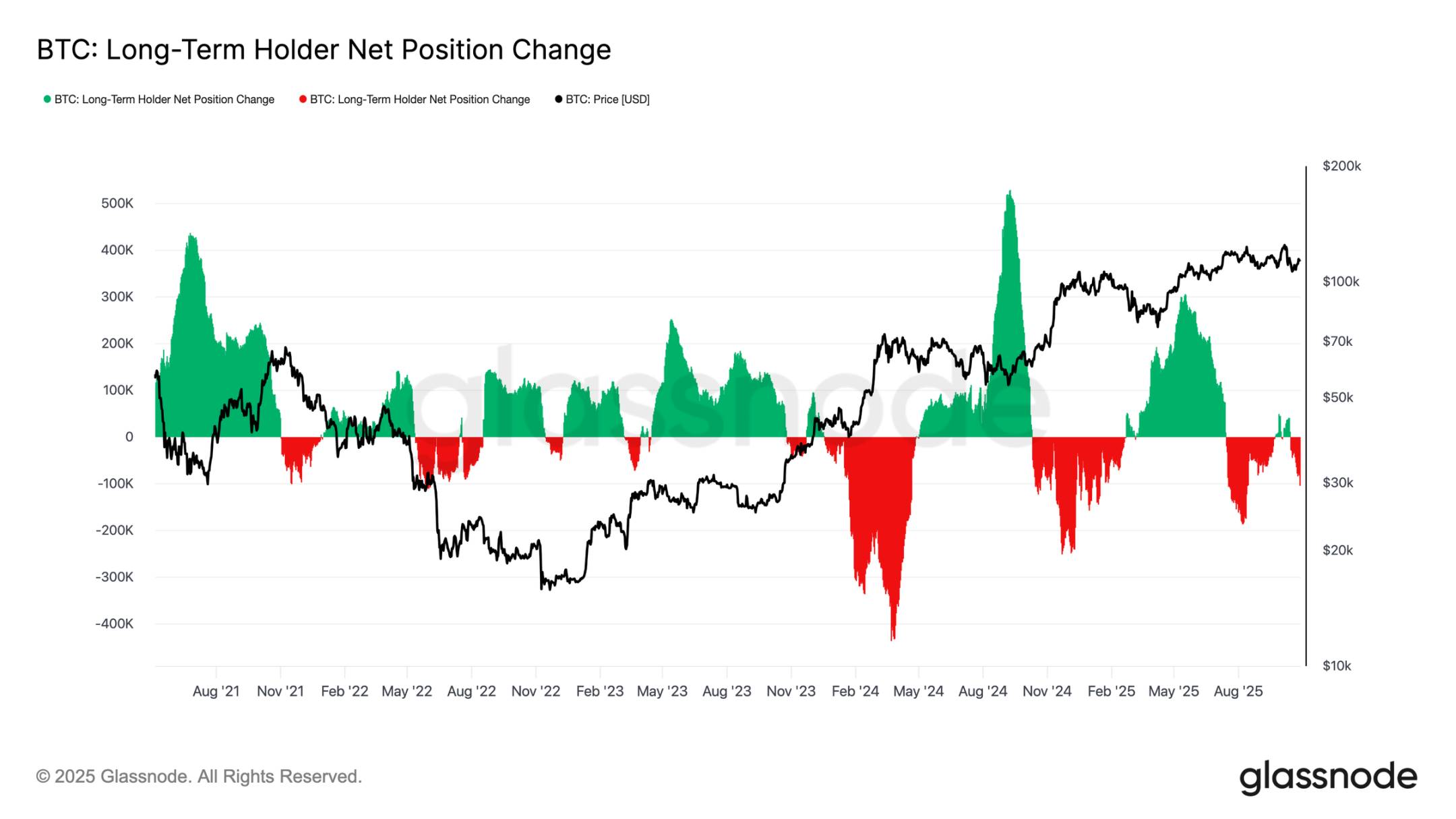
To gauge the intensity of long-term holder selling, we can look at the volume of long-term holder transfers to exchanges (30-day simple moving average), which captures the value of tokens moved by experienced investors for potential sale. This metric has soared to about $293 million per day, more than double the typical $100 million to $125 million benchmark seen since November 2024.
Such high transfer activity indicates long-term investors are consistently realizing profits, adding to ongoing selling pressure. The current pattern is very similar to August 2024, a period characterized by aggressive long-term holder spending as price momentum slowed. Unless this transfer flow subsides, spot demand will struggle to absorb the persistent selling, leaving the market vulnerable to further cooling in the coming weeks.
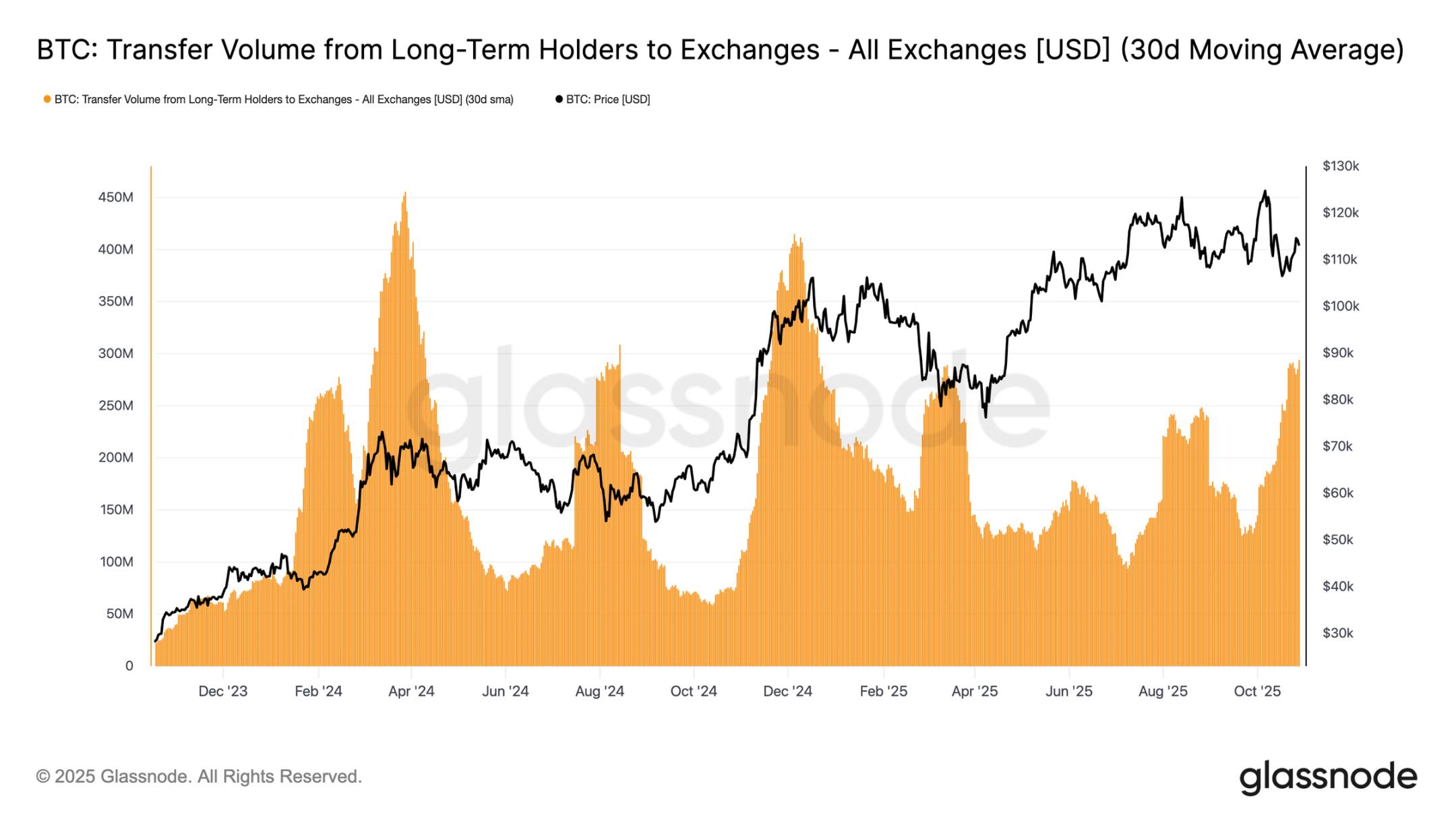
Off-chain Insights
Options Market Cools Down
Turning to the options market, recent data shows that volatility pressure has continued to ease following the October 10 crash. Bitcoin’s 30-day realized volatility has dropped to 42.6%, down slightly from last week’s 44%, reflecting calmer price action. Meanwhile, implied volatility, representing traders’ expectations, has fallen even more sharply as participants unwind downside hedges and reduce protection demand.
Shorter-dated contracts saw the largest adjustments, with 1-week at-the-money implied volatility dropping over 10 volatility points to around 40%, while 1-month to 6-month contracts slipped only 1–2 points, holding near the mid-40% range. This flattening of the term structure suggests traders expect fewer near-term shocks.
The curve also implies that expected volatility will rise slowly to about 45% over the coming months, rather than spike abruptly.
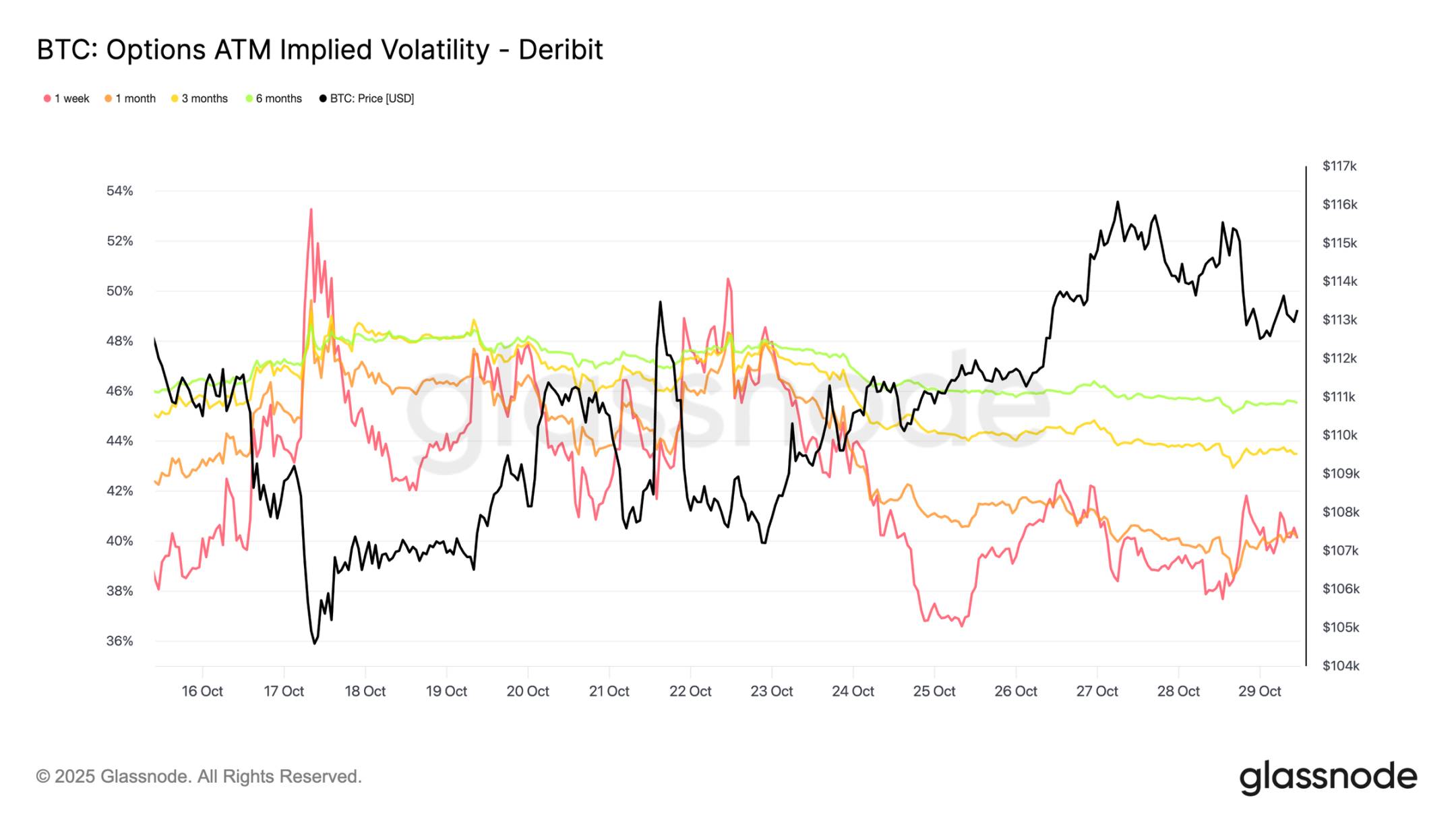
Skew Resets Lower
The easing in implied volatility has also translated into a significant shift in 25-delta skew, which measures the relative cost of puts versus calls. Positive skew indicates a premium for put options. After the October washout, 1-week skew spiked above 20%, signaling extreme demand for downside protection. Since then, it has collapsed to neutral levels, with only a slight rebound and much less intensity.
Longer-dated contracts, such as 1-month and 3-month tenors, have also reset sharply, showing only a moderate put premium. This shift suggests traders have removed most of their downside hedges. Positioning is now closer to “mildly bullish/two-way” rather than “panic new lows,” consistent with the broader stability seen in Bitcoin’s recent price action.
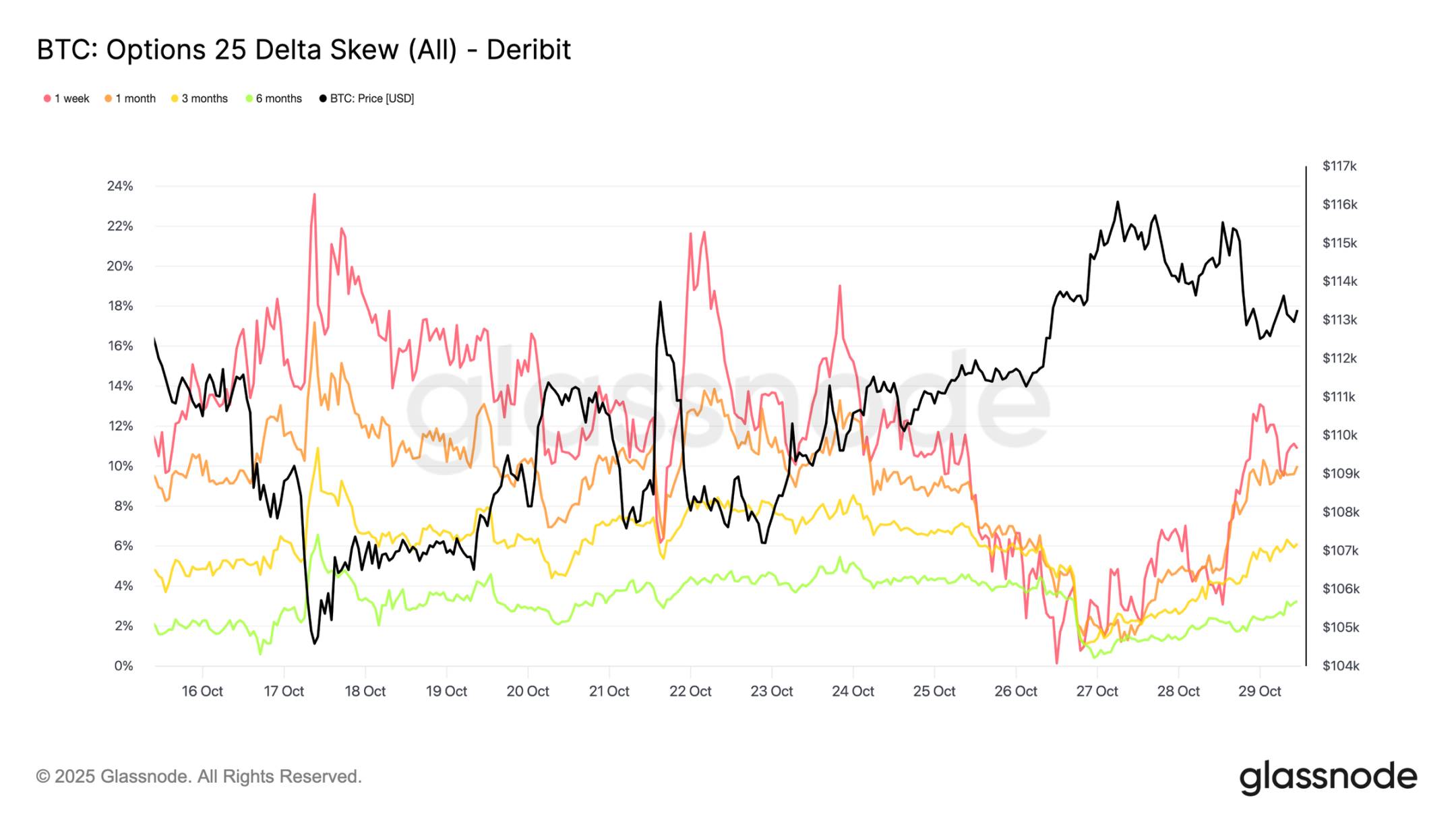
Selective Bullish Positioning
As skew normalizes, attention turns to where traders are allocating premium. Call option activity now varies significantly by strike price. At the $115K strike, net call option premium bought remains positive, indicating traders continue to pay for near-term upside as prices have recovered over the past two weeks. In contrast, at the $120K strike, more call premium is being sold than bought, resulting in a net negative premium.
This setup reflects a “mild rebound, not a full breakout” stance. Traders are willing to pay for gains closer to spot price, but finance these positions by selling calls at higher strikes. The resulting call spread structure suggests a cautiously optimistic outlook—seeking to participate in further upside, but lacking confidence in a full retest of all-time highs.
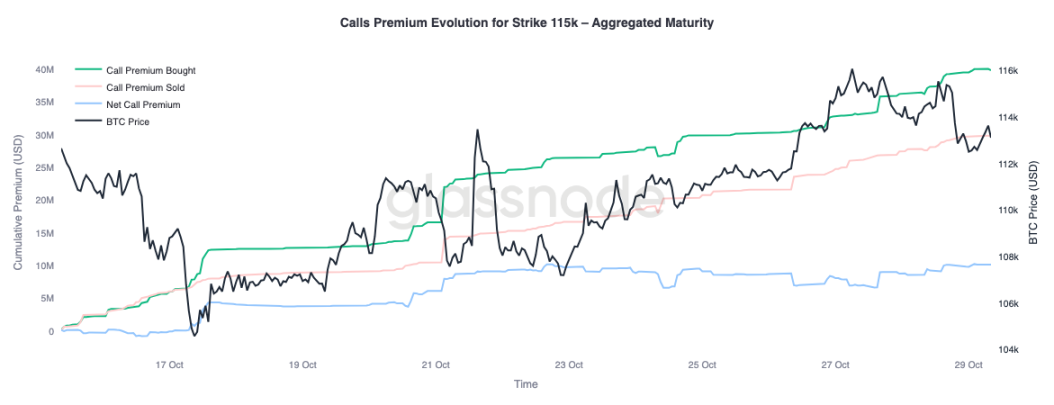
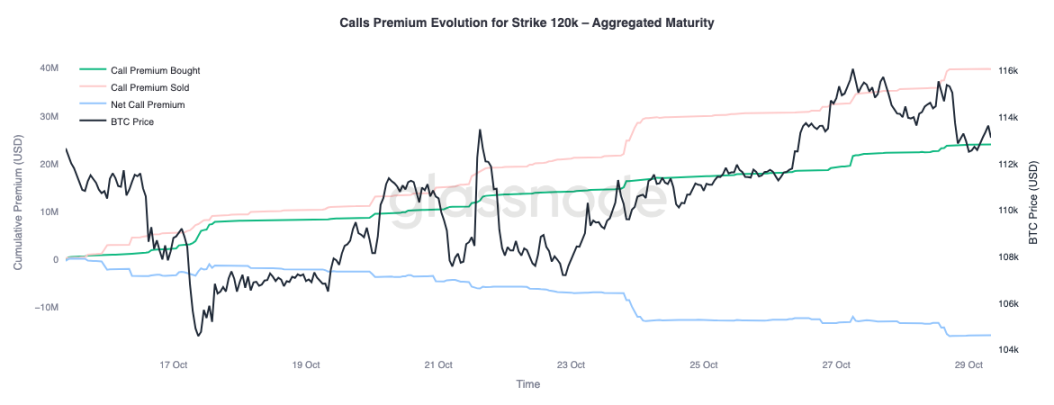
Market Pricing for Controlled Pullback
To complete the overall picture, we can turn to the put side of the market. Since October 24, as Bitcoin pushed higher, traders have been buying $110K puts, indicating demand for near-term downside protection. Meanwhile, $105K puts have been sold more aggressively, suggesting participants are happy to collect premium by providing insurance at this deeper strike.
This contrast highlights a market expecting a shallow pullback rather than another major liquidation wave. Traders appear to believe that consolidation near current levels is likely (hedging at $110K), but see a full break below $105K as less probable. Overall positioning supports the view that the worst of October’s deleveraging is over, and the market is now focused on range trading and volatility harvesting, rather than defensively hedging against another sharp sell-off.
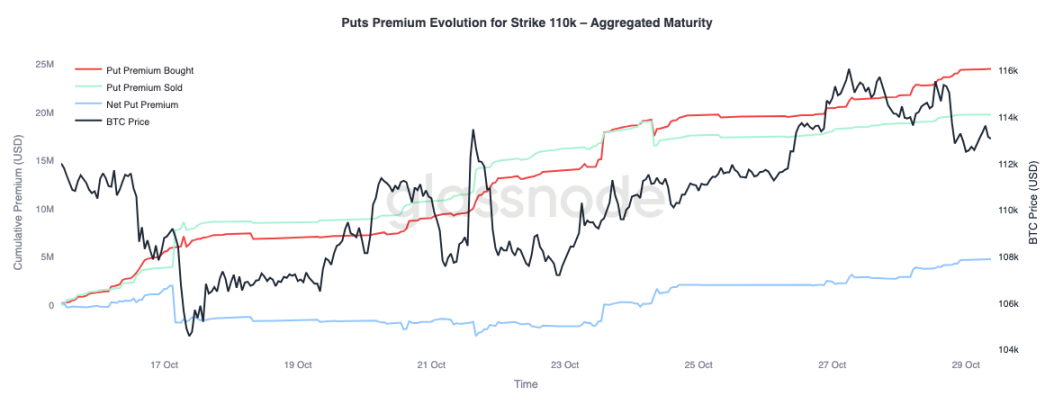
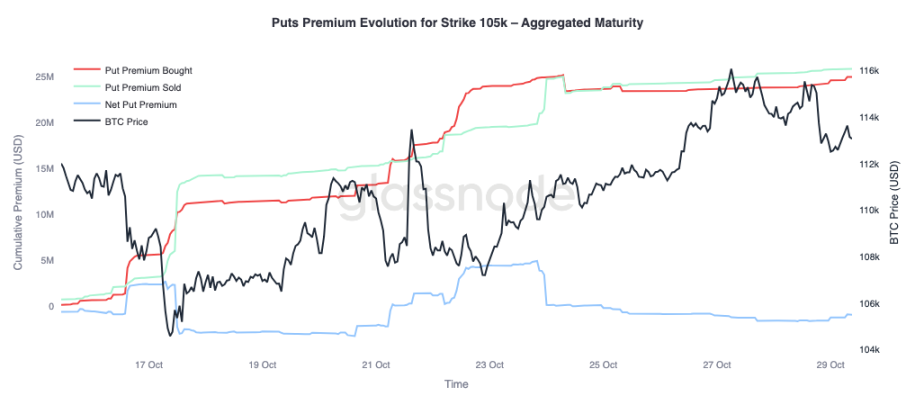
Conclusion:
The on-chain landscape continues to reflect a market in correction and recalibration. Bitcoin’s failure to hold above the short-term holders’ cost basis highlights fading momentum and ongoing selling pressure from both short- and long-term investors. Increased long-term holder selling and high transfer volumes to exchanges underscore a phase of demand exhaustion, suggesting the market may need an extended consolidation to rebuild confidence. Until long-term holders return to accumulation mode, upside recovery may remain limited.
Turning to the options market, front-end implied volatility has sharply declined, skew has normalized, and options flows now reflect controlled upside exposure and restrained downside hedging. Structurally, the crypto options market appears to be transitioning from crisis mode to rebuilding mode, indicating improved stability.
However, the next major catalyst is imminent—the Federal Reserve meeting. Rate cuts are largely priced in, meaning a dovish outcome is likely to keep volatility suppressed and skew balanced. Conversely, if the Fed delivers a smaller cut or maintains a hawkish tone, short-term implied volatility could rise again, and 25-delta skew could widen as traders rush to repurchase protection. In essence, the current market calm is conditional—stable for now, but fragile if the Fed deviates from expectations.



